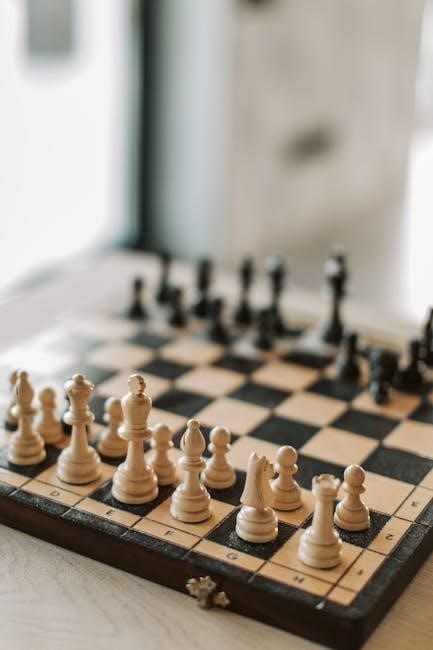Chess for Beginners PDF: A Comprehensive Guide
Embark on a journey into the captivating world of chess! This guide provides a comprehensive introduction, designed specifically for beginners․ Learn the rules, understand piece movements, and develop basic strategies․ Discover resources, including PDF guides, to enhance your learning and enjoyment of this strategic game․
Chess, a game of strategy originating in India over 1500 years ago, is a timeless pastime enjoyed by millions worldwide․ This comprehensive guide welcomes beginners, providing a clear and accessible pathway to understanding the fundamentals of chess․ We’ll explore the basic rules, piece movements, and essential strategies that form the foundation of successful gameplay․ Chess is more than just a game; it’s a mental exercise that enhances critical thinking, problem-solving skills, and strategic foresight․
Whether you’re completely new to the game or have a passing interest, this guide will equip you with the knowledge and resources needed to confidently navigate the chessboard․ Learn how to avoid early opening disasters, and progressively develop your skills․ Let’s embark on this exciting chess journey together, unlocking the secrets and strategies that make chess a captivating and rewarding experience for players of all levels․ Discover the joy and challenge that chess offers, and prepare to sharpen your mind with every move!
Basic Chess Rules and Objectives
Understanding the fundamental rules is crucial to playing chess effectively․ The primary objective in chess is to checkmate your opponent’s King․ This means placing the King under immediate attack (in “check”) such that there is no way to remove it from attack․ A chess game involves two players, each controlling 16 pieces: a King, Queen, two Rooks, two Bishops, two Knights, and eight Pawns․ The game begins with White making the first move, followed by alternating turns․
Each piece has unique movement capabilities․ Pawns generally move one square forward, but can move two squares on their first move․ The King can move one square in any direction․ The Queen is the most powerful, moving any number of squares horizontally, vertically, or diagonally․ Rooks move horizontally or vertically, Bishops move diagonally, and Knights move in an “L” shape․ Capturing involves moving your piece to a square occupied by an opponent’s piece, removing the opponent’s piece from the board․ Mastering these rules is your first step toward chess proficiency!
The Chessboard and Pieces
The chessboard consists of 64 squares arranged in an eight-by-eight grid, with alternating light and dark squares․ Each player starts with 16 pieces․ Correct board orientation is essential: the bottom-right square from each player’s perspective must be a light square․ The pieces are arranged identically on both sides․ The back rank, closest to each player, houses the major pieces․ From left to right, the standard setup is Rook, Knight, Bishop, Queen, King, Bishop, Knight, Rook․
In front of the major pieces lies the row of eight pawns․ White’s pieces are placed on ranks 1 and 2, while Black’s pieces occupy ranks 7 and 8․ Understanding the starting position and the names of each piece is fundamental․ Each piece possesses a unique movement style, contributing to the strategic depth of chess․ Proper setup and piece recognition are the initial steps in learning to play and appreciate the game of chess․ Familiarity with the board and pieces will set you up for success․

The Pawn

The pawn, seemingly simple, is a crucial piece in chess․ Each player begins with eight pawns, forming the front line of their army․ Pawns possess unique movement capabilities․ On its first move, a pawn can advance either one or two squares forward along its file․ Subsequently, it can only move one square forward at a time․ Pawns cannot move backward․

The pawn’s attack is diagonal, one square forward․ This means a pawn attacks squares different from those it occupies or moves to․ If a pawn attacks an enemy piece, it captures it and occupies that square․ Pawns have a special move called “en passant,” a French term meaning “in passing․” If a pawn moves two squares from its starting position and lands beside an opponent’s pawn, the opponent can capture it as if it had only moved one square․ Pawn structure significantly influences the game․
The Rook
The rook, often visualized as a castle tower, is a powerful piece in chess, known for its straight-line movement․ Each player starts with two rooks, positioned on the corners of the board․ The rook can move any number of squares horizontally or vertically along ranks and files, respectively, provided its path is not blocked by its own pieces or an opponent’s piece․
Rooks are particularly effective in open positions where they have clear pathways to attack․ They become increasingly valuable as the game progresses and the board opens up․ Rooks are also involved in a special move called castling, where the king and one of the rooks move simultaneously․ Castling is a crucial defensive maneuver that protects the king and brings a rook into play․ Mastering the rook’s movement and strategic value is essential for chess players․
The Knight
The knight is arguably the most unique piece in chess, distinguished by its unusual “L-shaped” movement․ Unlike other pieces that move in straight lines, the knight jumps to a square that is two squares in one direction (horizontally or vertically) and then one square perpendicularly․ This means the knight always moves to a square of a different color than the one it currently occupies․
Each player starts with two knights, positioned between the rooks and the bishops․ The knight is the only piece that can jump over other pieces, making it particularly effective in closed positions where pawns and other pieces restrict movement․ Mastering the knight requires understanding its complex movement pattern and strategic positioning․ Knights are strong attacking pieces and can be particularly effective in forking multiple pieces simultaneously․ Their unpredictable movement makes them a valuable asset in both attack and defense․
The Bishop

The bishop is a long-range piece in chess, moving diagonally across the board․ Each player begins with two bishops: one that moves on the light squares and one that moves on the dark squares․ These bishops are confined to their respective color complexes throughout the game, meaning a light-squared bishop can never move to a dark square, and vice versa․
Bishops are most effective in open positions where they have clear diagonal lines to operate on․ They can control important squares, attack from a distance, and support other pieces․ A pair of bishops, working together, can be a powerful attacking force, covering both light and dark squares․ Understanding the strengths and limitations of bishops is crucial for developing a solid chess strategy․ Players should aim to activate their bishops early in the game and find open diagonals where they can exert maximum influence․
The Queen
The queen is the most powerful piece on the chessboard, combining the movement capabilities of both the rook and the bishop․ She can move any number of squares horizontally, vertically, or diagonally, making her a versatile attacking and defensive asset․ Each player starts with one queen, positioned on her own color on the first rank – the white queen on a light square and the black queen on a dark square․
Due to her immense power, the queen is often a primary target for the opponent’s pieces․ It’s crucial to develop the queen with caution, avoiding early exposure to attacks․ A well-placed queen can control vast areas of the board, dominate key squares, and deliver devastating attacks․ Players should aim to find active positions for their queen, supporting their pieces and threatening the opponent’s king․
The King

The king is the most important piece in chess, although not necessarily the most powerful in terms of movement․ The primary objective in chess is to checkmate the opponent’s king, placing it under an inescapable threat of capture․ The king can move one square in any direction: horizontally, vertically, or diagonally․
While the king’s movement is limited, its safety is paramount․ Protecting the king is a central theme throughout the game․ Castling is a special move involving the king and one of the rooks, allowing the king to move two squares towards the rook, and the rook hops over the king to land on the adjacent square․ This move enhances the king’s safety and connects the rooks․
Unlike other pieces, the king cannot move to a square where it would be under attack․ At the endgame, the king becomes a more active piece, supporting pawn advances and participating in attacks․
Basic Chess Strategies for Beginners
Once you understand the rules and piece movements, it’s time to explore basic chess strategies․ These strategies will help you make informed decisions and improve your gameplay․ Focus on controlling the center of the board, as central squares offer greater mobility and influence over the game․
Develop your pieces early in the game․ Bring your knights and bishops into active positions where they can control key squares and support your pawns․ Avoid moving the same piece multiple times in the opening, unless there’s a clear tactical reason to do so․ Coordinate your pieces to work together effectively․

Protect your king by castling․ Castling brings your king to a safer location and connects your rooks, improving your defensive structure․ Be mindful of pawn structure, as it affects piece mobility and king safety․ Plan your moves, anticipate your opponent’s responses, and always be aware of potential threats and opportunities․
Opening Principles
The opening phase of a chess game sets the stage for the middlegame and endgame․ Adhering to sound opening principles will give you a solid foundation․ The primary goal in the opening is to control the center of the board․ Central control provides greater mobility for your pieces and restricts your opponent’s options․ Pieces like knights and bishops are more effective when they control central squares․
Develop your pieces actively and efficiently․ Bring your knights and bishops off the back rank and into positions where they can influence the game․ Avoid moving the same piece multiple times in the opening unless it’s absolutely necessary․ Aim to coordinate your pieces, so they work together harmoniously․
Prioritize king safety by castling early․ Castling gets your king out of the center and connects your rooks․ Be mindful of pawn structure, as it can impact piece activity and king safety․ Avoid premature attacks and focus on building a solid position․ Remember, a good opening leads to a better middlegame․
Basic Tactics: Forks, Pins, and Skewers
Tactics are short-term, calculated sequences of moves that aim to gain a material advantage or improve your position․ Mastering basic tactics is crucial for chess improvement․ A fork occurs when a single piece attacks two or more of the opponent’s pieces simultaneously․ Knights are particularly adept at executing forks due to their unique movement pattern․
A pin occurs when a piece cannot move without exposing a more valuable piece (or the king) to attack․ Pins can restrict the opponent’s mobility and create tactical opportunities․ A skewer is similar to a pin, but the more valuable piece is directly attacked, forcing it to move and exposing the less valuable piece behind it․ Skewers can lead to immediate material gain․
Practice identifying these tactical motifs in your games and training exercises․ Look for undefended pieces and vulnerable squares․ Calculating variations accurately is essential for successful tactical execution․ By developing your tactical vision, you can seize opportunities and punish your opponent’s mistakes․
Chess Endgame Basics
The endgame is the final phase of a chess game, typically characterized by fewer pieces on the board․ Endgame principles differ significantly from opening and middlegame strategies․ King activity becomes paramount in the endgame, as the king can actively participate in attacking and defending․ Pawn structure is also crucial, as passed pawns (pawns with no opposing pawns to prevent their advance) can be decisive․

One of the most fundamental endgame concepts is opposition, where kings face each other with an odd number of squares between them․ Gaining the opposition often allows you to control key squares and force the opponent’s king to retreat․ Another important skill is knowing how to promote pawns to queens effectively․ This often involves careful calculation and maneuvering to avoid stalemate․
Studying basic king and pawn endgames is essential for beginners․ These positions demonstrate fundamental principles and techniques that can be applied to more complex endgames․ Understanding the endgame will improve your overall chess ability and help you convert winning positions into victories;
Resources for Learning Chess: PDF Guides
Numerous PDF guides are available online to help beginners learn chess․ These resources offer a structured approach to understanding the game, covering topics from basic rules to fundamental strategies․ Many guides include diagrams and exercises to reinforce learning and improve pattern recognition․

One popular type of PDF guide focuses on introductory lessons, explaining the movement of each piece and the basic objectives of the game․ These guides often include simple checkmating patterns and tactical exercises to get beginners started․ Other PDF guides delve into specific areas, such as opening principles, endgame techniques, or tactical motifs․

When selecting a PDF guide, consider your current skill level and learning style․ Some guides are designed for complete beginners, while others are more suitable for those with some prior knowledge․ Look for guides that provide clear explanations, relevant examples, and practical exercises․ Many websites and chess organizations offer free or low-cost PDF guides that can significantly accelerate your chess learning journey․ Supplementing your learning with these resources will provide a strong foundation for chess improvement․

Be First to Comment